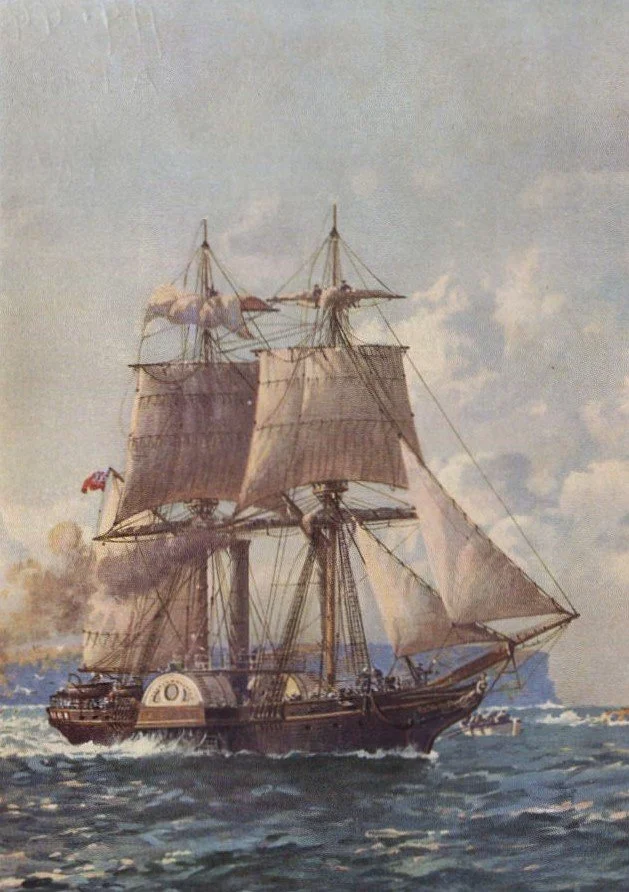A deep-water river port
Why did Maitland prosper and rise to prominence in the middle of the nineteenth century? What did Maitland have that other settlements in the colony did not?
There is no single answer to the first question but there is a definite answer to the second. While other regions also had fertile, well-watered agricultural land, Maitland had more: it possessed a deep-water river port, the rise of which coincided with the arrival of reliable steam sea transport between the productive lower Hunter valley and the colony’s principal market in Sydney.
The port was on the property of Edward Charles Close at Green Hills, now Morpeth, and it was strategically located at the head of navigation for sea-going vessels. Immediately upstream, the river was considerably shallower and impassable for such ships.
The first two steamships to ply the river between Sydney and Morpeth were the British-built Sophia Jane and the William the Fourth (William IV) which was built at a dockyard on the Williams River.
Sophia Jane
Sophia Jane
(H M Abbott, The Newcastle Pockets and the Hunter Valley, 1943)
The Sophia Jane arrived from England on 13 May 1831. She was a flush-decked, schooner-rigged paddleship, 126 feet long, 20 feet wide and of 256 tons. Equipped with 50 horsepower engines, sails as a source of auxiliary power and a draught of six feet, she could make eight miles an hour in smooth water.
She had 16 berths in the men's first saloon cabin, 11 in the ladies', and could take 20 steerage passengers. The Sophia Jane plied between Sydney and Green Hills, which became a vital trade route from the 1830s. She had various owners over a period of a few years, lay idle in Sydney for a time but plied the Hunter into the 1840s.
William the Fourth (William IV)
William IV
(H M Abbott, The Newcastle Pockets and the Hunter Valley, 1943)
A few months after the Sophia Jane began service, she was joined by the William IV, also a schooner-rigged paddleboat but locally built by Marshall & Lowe at Erringhi (now Clarence Town) of local Australian 'flooded gum'. Clarence Town was to be the site of substantial ship-building activity for many years.
William IV was launched on 22 October 1831, at Clarence Town. She was 80 feet long, 20 feet wide and had a draught of six feet and a speed of about seven miles an hour.
The vessel made its first trip to Newcastle in February 1832. She was advertised to leave Sydney every Monday evening at seven and to receive and discharge goods at Mr Walker's store on Close's land at Green Hills. The fare from Sydney to Green Hills was 25/- cabin, 15/- steerage, and to Newcastle 20/- cabin and 12/6 steerage. Like the Sophia Jane, she was bought and sold periodically over the years, was idle in Sydney for a time during the late 1830s but worked the Morpeth-Sydney route into the 1840s.
The William IV also transported goods and people up what was known at the time as the ‘second branch’ of the Hunter (now the Paterson River). Thus Mrs Broughton, wife of the Bishop of Australia (William Broughton) and returning from a visit to Gresford early in 1840 with her two daughters, caught William IV at Paterson.
The impact of the two steamships
Whilst these two steamers were the first, they were only the forerunners of a constant coming and going of ships between Sydney and Green Hills. Of course, these vessels were small compared with those of later decades but they were witness to the increasing activity and great productivity of the valley of the Hunter River. They were central to the economic development of Maitland and its region (including areas beyond the Great Divide) during the 1830s before being superseded by larger vessels with greater load capacities.
Morpeth, with four wharves and a large number of inns by the middle of the nineteenth century (nine in 1858), was the port on the Hunter River. For decades it was of far greater importance than the port at Newcastle in terms of tonnages loaded and unloaded and diversity of cargo. The Sophia Jane and the William IV were early parts of the achievement of this status.
Port of Morpeth, 1865
(‘Morpeth’, Illustrated Sydney News, 16 October 1865)
Steamships were still operating but the Sophia Jane and William IV were long gone.
References
Abbott, J H M, The Newcastle Packets and the Hunter Valley, The Currawong Publishing Co, Sydney, 1943.
Elkin, A P, The Diocese of Newcastle, Australian Medical Publication Company, Glebe, 1955.
Short, Kevin, ’Our past: deep water port was what gave Maitland the edge’, Maitland Mercury, 10 May 2020.



